When my mom and I got to the archaeological site of Abu Simbel back in 2001, we joined a group with a guide, but I soon concluded that the guide was not telling anything that I had not already known. So, the two of us left them and headed for the interior of the temple, which was an excellent decision. Firstly, because there were not too many people inside and we could better look at the interior of the temple.
The structure of the temple is quite complex and it includes several side rooms, but the visitor first enters a hypostyle hall, i.e., a hall with pillars. To the left and right of this first room there are four pillars each, around 8 m high, and adjacent to them there are statues in the shape of deified Ramesses II who is here associated with god Osiris. Since among other things Osiris is the god of fertility, the afterlife, the dead and the resurrection, this suggests the eternal nature of the pharaoh. The statues on the left-hand side wear the crown of Upper Egypt, while those on the right-hand side have the double crown of Upper and Lower Egypt. As a reminder, this was all chiselled into the depth of a rocky mountain slope. The ceiling is decorated with paintings of flying vultures.
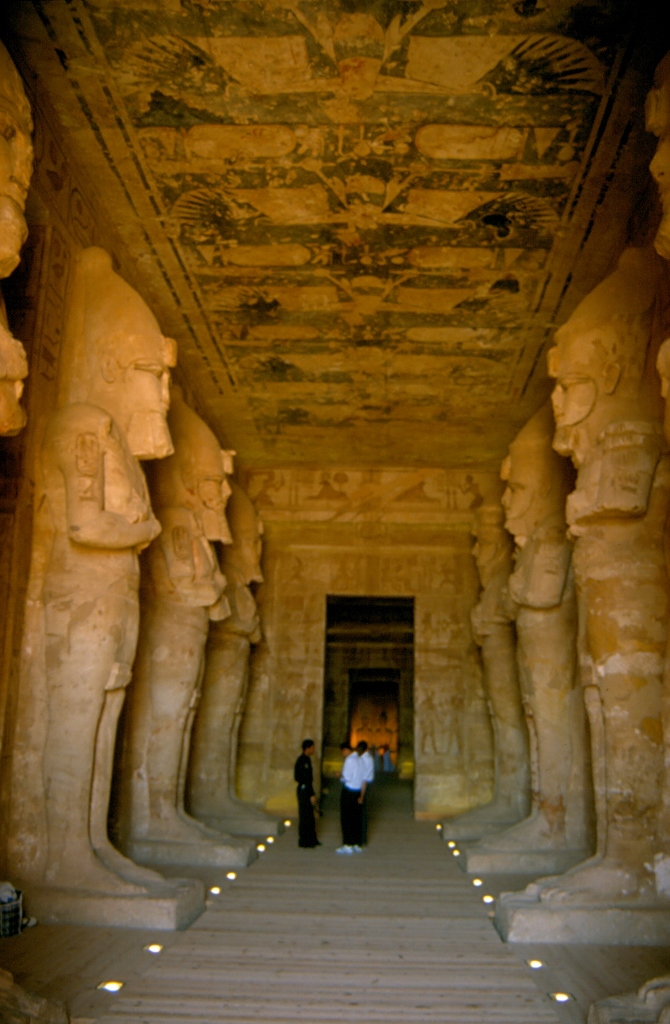 Abu Simbel, the Great Temple, the hypostyle hall
Abu Simbel, the Great Temple, the hypostyle hall
The hypostyle hall is 18 m long and almost 17 m wide. Going straight from this hall, the visitor enters another, smaller hall with pillars, as well as several side rooms. And all the walls are decorated with bas-reliefs. Below is a series of photos made from a video, since the proper photos I made inside were all dark and far too blurry. Even those I included here into the travelogue are not spectacular, but I don’t have any better.
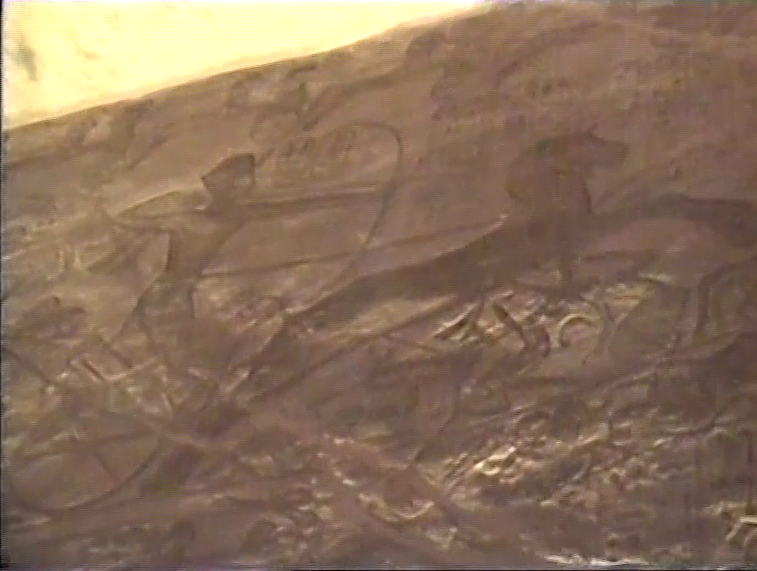 Abu Simbel, the Great Temple
Abu Simbel, the Great Temple
Generally speaking, the bas-reliefs in the hypostyle hall deal with the glorification of the pharaoh, this time through his numerous military campaigns. Particularly interesting are the depictions of the Battle of Kadesh that was fought in 1296 BCE between the Egyptians and the Hittites. Although Ramesses II is shown as the victor here, on the basis of some other evidence, as well as a record found during the excavations of Hattusa, the capital of the Hittite Empire, it is believed that the final result was a tie. Still, this battle continues to be one of the most famous in the world, since the first peace treaty in the history was signed after this particular battle (at least that we know of).
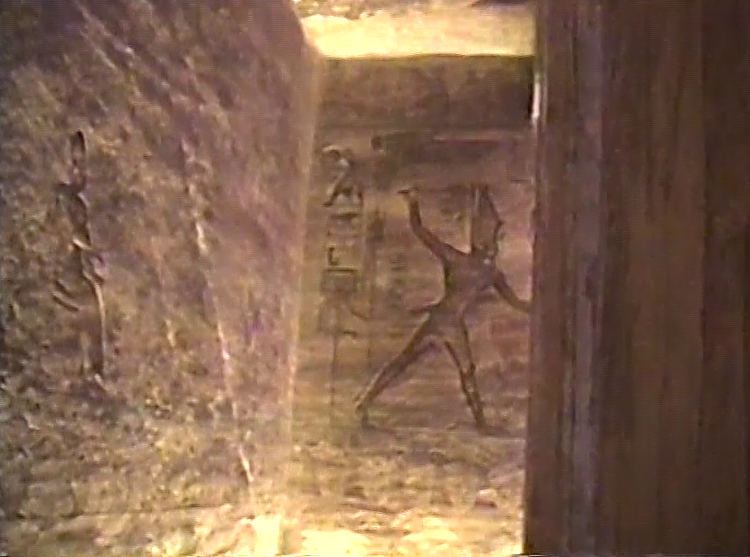 Abu Simbel, the Great Temple, the interior decoration
Abu Simbel, the Great Temple, the interior decoration
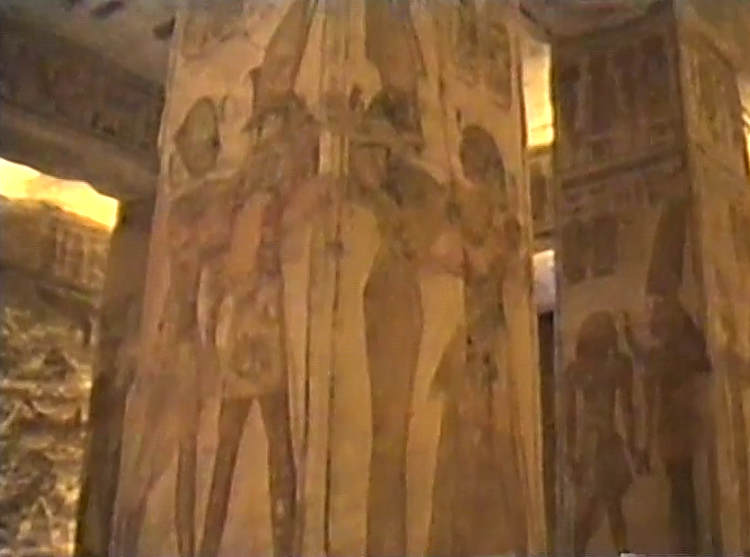 Abu Simbel, the Great Temple, the decoration on the pillars in the hypostyle hall
Abu Simbel, the Great Temple, the decoration on the pillars in the hypostyle hall
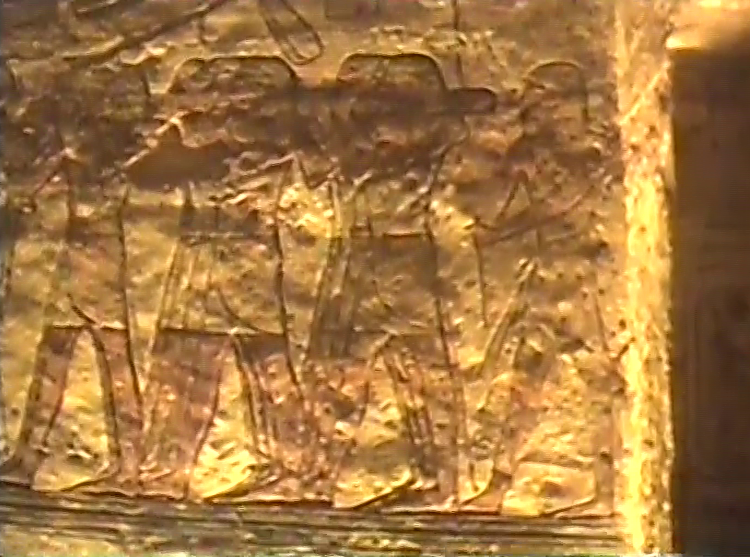 Abu Simbel, the Great Temple, the interior decoration
Abu Simbel, the Great Temple, the interior decoration
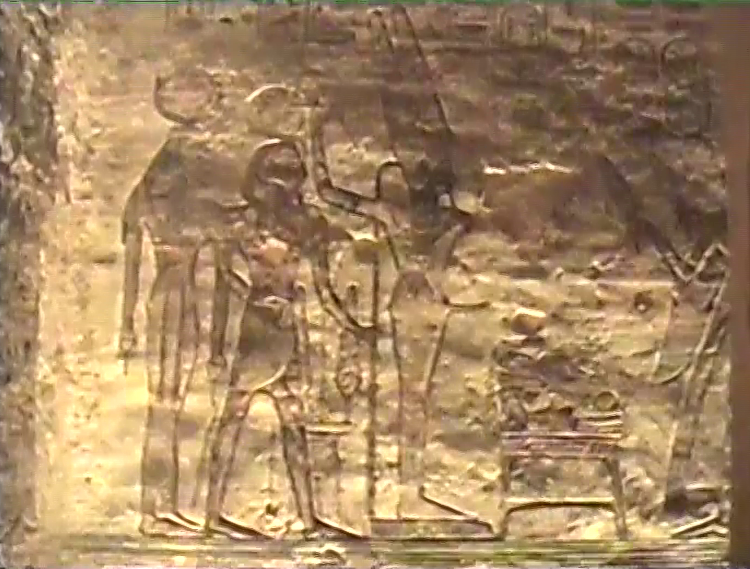 Abu Simbel, the Great Temple, the interior decoration
Abu Simbel, the Great Temple, the interior decoration
So, from the hypostyle hall one enters a smaller hall with pillars and from there further to the very sanctuary on the back wall of which there are the sitting figures of gods Ptah, Amun-Ra, deified Ramesses II and Ra-Horakhty. This sanctuary is 47 m away from the entrance and 61 m from the surface of the mountain slope. Again, all of this was done by chiselling.
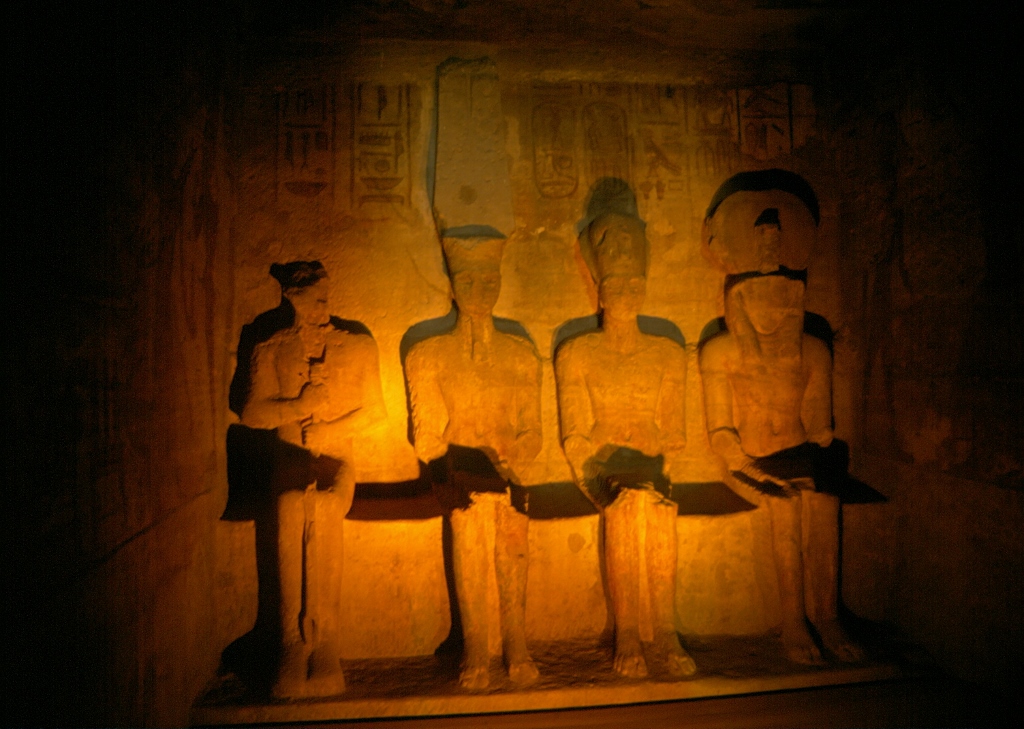 Abu Simbel, the Great Temple, the sanctuary
Abu Simbel, the Great Temple, the sanctuary
In the photo above, from left to right there are the sitting figures of god Ptah, god Amun-Ra, deified Ramesses II and god Ra-Horakhty.
What is very often mentioned in connection with this sanctuary is the phenomenon of its being lit by the rising Sun. Namely, to start with, the front facade of the temple faces east, so that the central position of the god of the rising Sun, Ra-Horakhty, above the entrance to the temple gets added and quite reasonable meaning. In addition, twice a year, on 22 February and 22 October (some sources say on 26 February and 18 October), when the Sun rises, its rays penetrate deep into the interior of the temple, all the way to the sanctuary where they light all the figures in the back, except for god Ptah since he is associated with the realm of the dead and thus he always stays in the dark, literally. This is at least the official story. On the other hand, I have also read that this lighting, which, it appears, is rather unconvincing, takes place over a period of 25 days after the autumnal equinox and 25 days after the vernal equinox, and that during this time it does light the figures, but never more than two at the time. Be as it may, the Ancient Egyptians did position their temple in this way and so when the temple was to be relocated to its new site in 1968 the scientists had to work very hard to make sure that the position of the temple was exactly such that this phenomenon continued to take place year in year out. One should not mess up with gods.
As a matter of coincidence, my mom and I happened to come here on 21 March, in other words right around the vernal equinox, but still far too late after the sunrise to be able to check the accuracy of all these stories. However, coming here on a vernal equinox which is considered a very important date in many beliefs and among many New Age oriented individuals and groups had its additional perk and that brings me to the second reason why it was an excellent idea for the two of us to enter the temple before the hordes of tourists. Namely, in this way, we managed to come across a few women who were doing a ritual or some invocations in the sanctuary. Here is a video clip where it will be possible to hear and see a part of the ritual, while also showing a little better the interior of the temple.
As you can see from the video, after reaching the sanctuary, I continued with the visit to the temple by going to the side rooms. Some of them are believed to have served as storage rooms. But, regardless of their function, they were also very opulently decorated, although the ceilings were significantly lower in comparison to the central section of the temple.
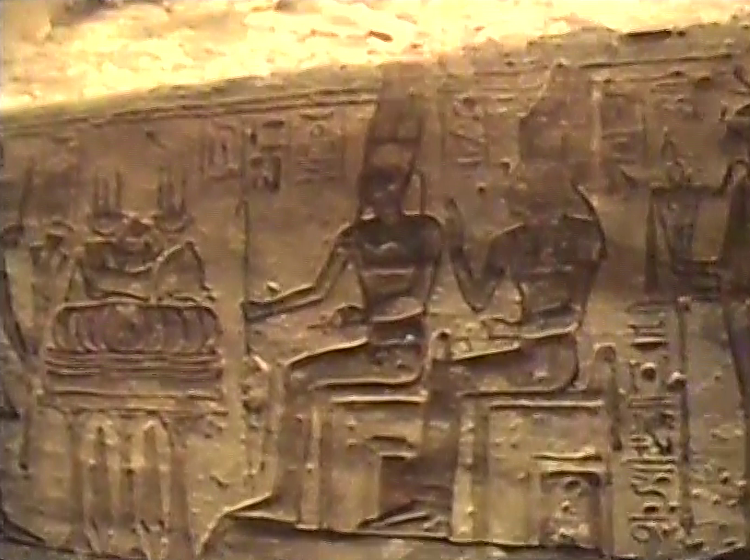 Abu Simbel, the Great Temple, the interior decoration
Abu Simbel, the Great Temple, the interior decoration
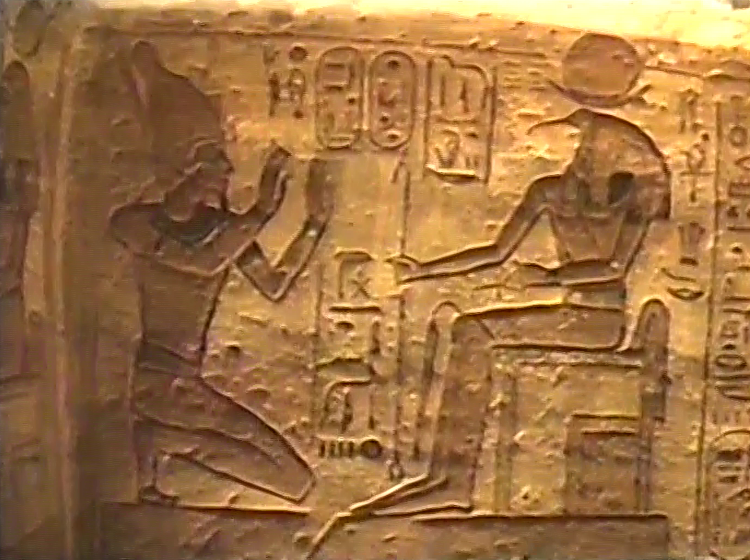 Abu Simbel, the Great Temple, the interior decoration
Abu Simbel, the Great Temple, the interior decoration
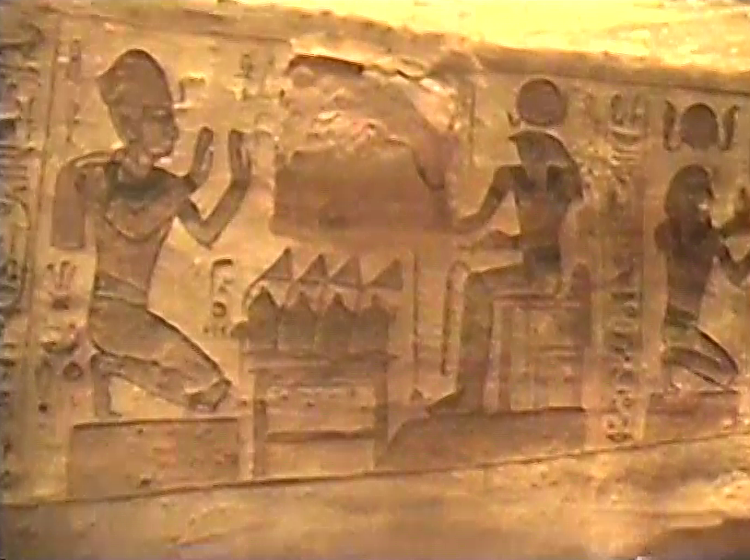 Abu Simbel, the Great Temple, the interior decoration
Abu Simbel, the Great Temple, the interior decoration
After this, we got out of the Great Temple in Abu Simbel and took some photos.
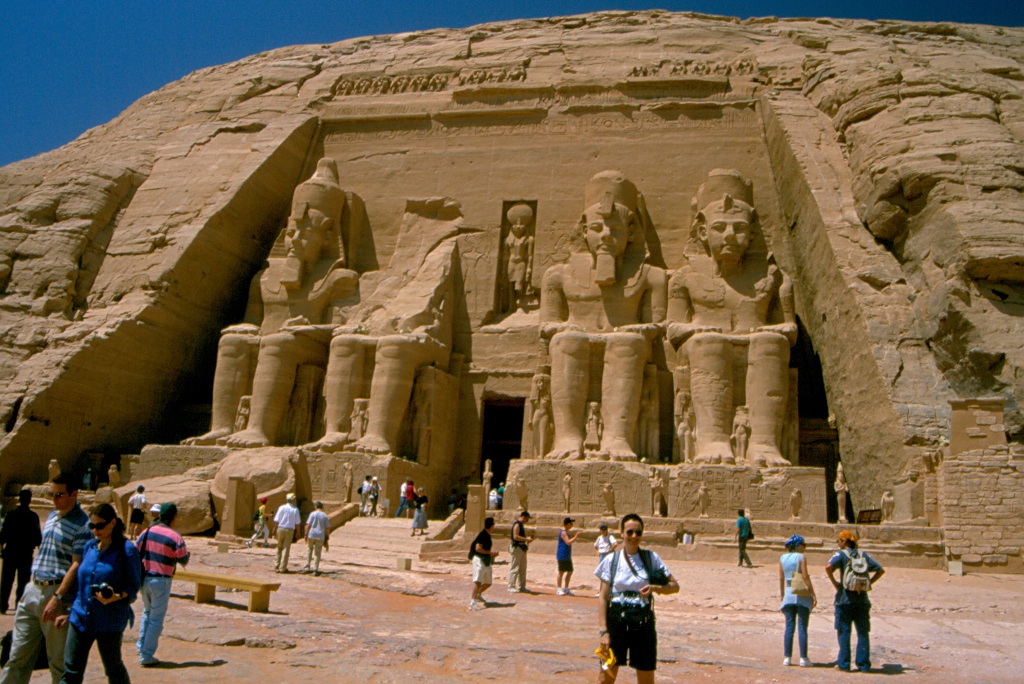 Abu Simbel, the Great Temple
Abu Simbel, the Great Temple
Then, my mom and I headed for the other temple, but all the time looking back at the Great Temple which is truly magnificent.
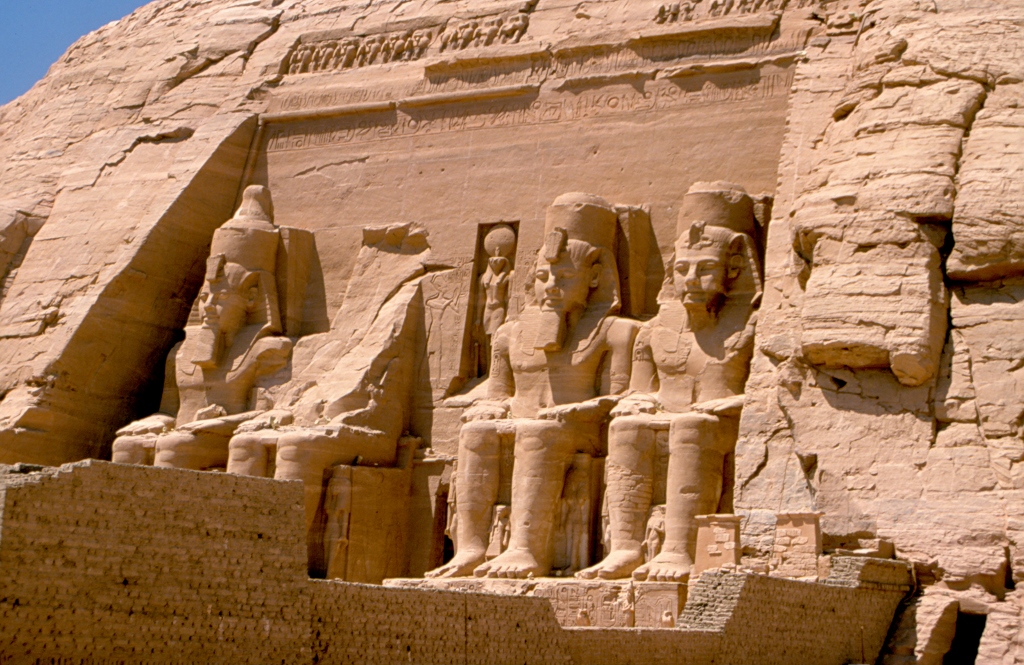 Abu Simbel, the Great Temple
Abu Simbel, the Great Temple
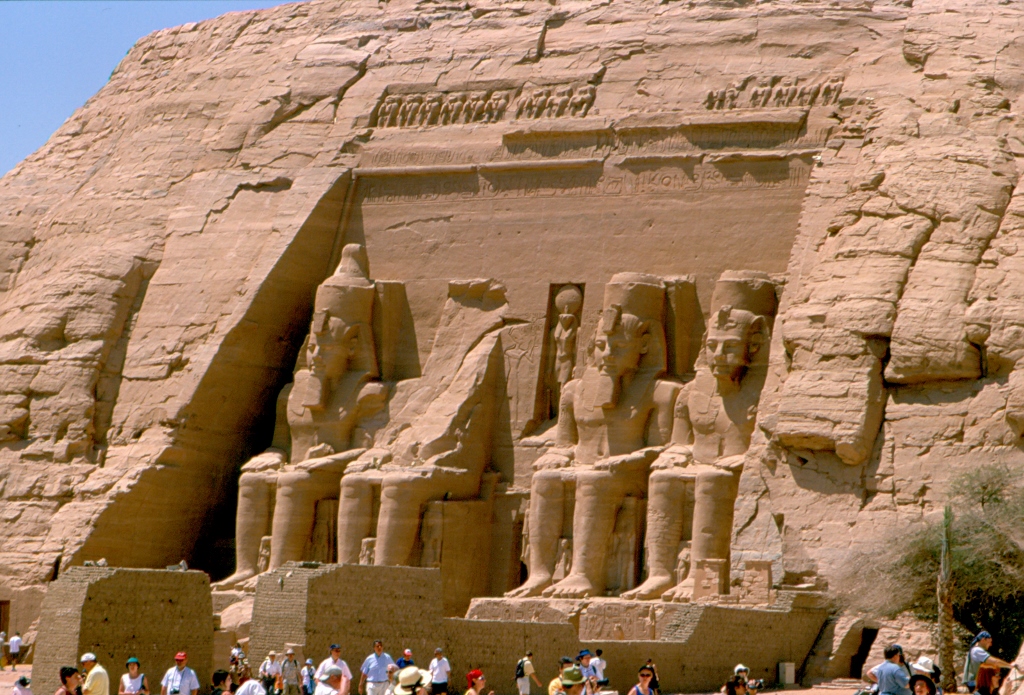 Abu Simbel, the Great Temple
Abu Simbel, the Great Temple
At some point, on a plateau between the two temples, there were hardly any people and so my mom and I took the opportunity and posed for a wonderful memory.
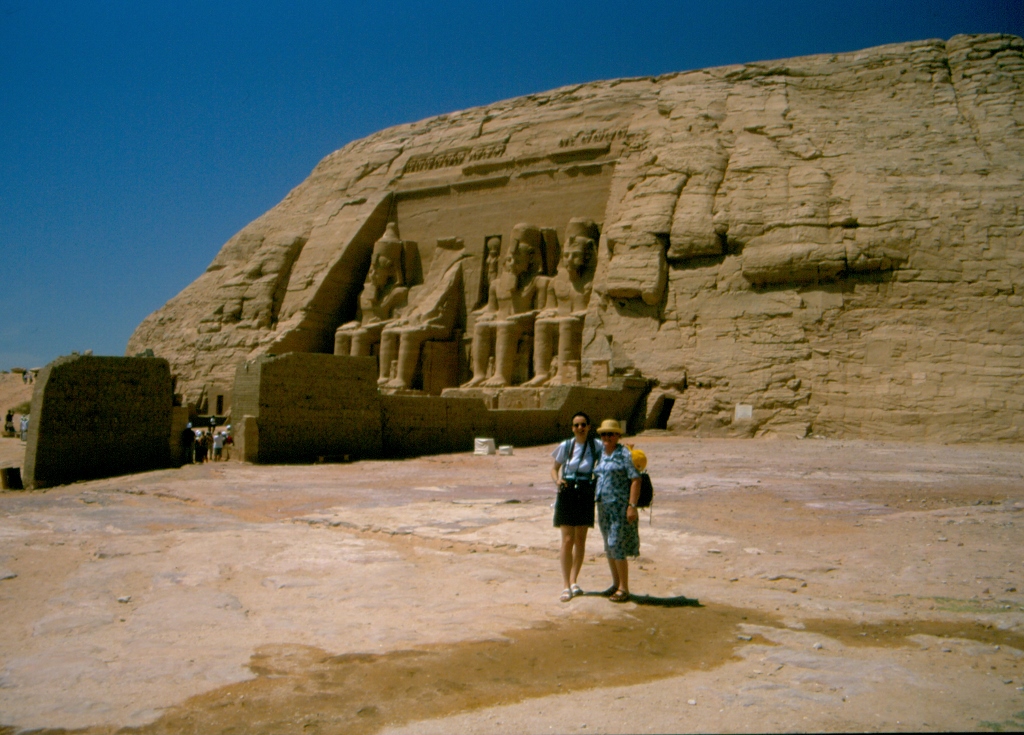 Abu Simbel, the Great Temple, my mom and I
Abu Simbel, the Great Temple, my mom and I
And then the plateau got crowded again.
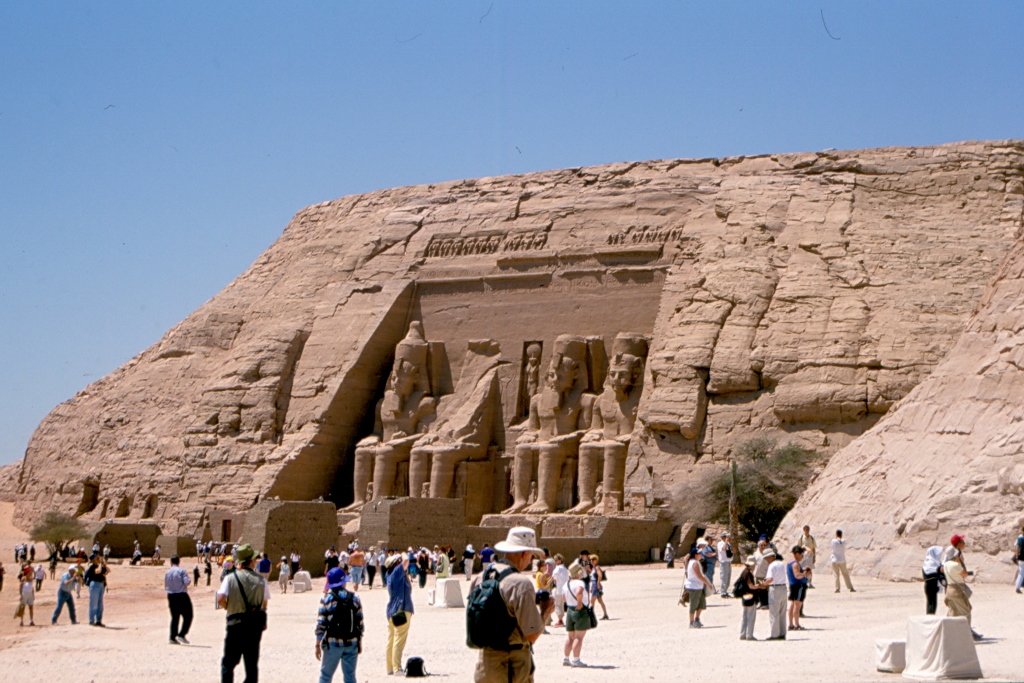 Abu Simbel, the Great Temple
Abu Simbel, the Great Temple
This is also where the Small Temple in Abu Simbel is located and this one is dedicated to goddess Hathor and queen Nefertari. Goddess Hathor is a daughter of god Ra, as well as his wife. She is also the mother of Horus (along with the already mentioned Isis), as well as his wife. This may all seem quite confusing, not knowing who is what to whom, but this is the Ancient Egyptian religion and it should be simply accepted as such. The logic is of lesser importance here.
What is important though is goddess Hathor who is often depicted as a cow or, if she is in a human form, then with cow horns on her head. She is, among other things, the goddess of the sky, love, music, dance, happiness and motherly care. She could also move between the worlds, thus helping the deceased on their way to the afterlife.
On the other hand, queen Nefertari was the chief wife of Ramesses II. Her name means “the beautiful companion” and it is believed that she was the favourite wife of this powerful pharaoh.
The temple dedicated to the two of them is around 100 metres away from the Great Temple. It is interesting that this was only the second temple in the history of Ancient Egypt dedicated to a queen. (The first one was built by Akhenaten from the 18th dynasty for his wife Nefertiti).
The front side of the temple was made as a mildly sloping facade and it is decorated with large statues of pharaoh Ramesses II and queen Nefertari placed into the cavities flanking the entrance – two pharaoh statues on each side between which there is one statue of the queen. Smaller statues of their children are placed beside their legs. On the inclined rock projections that separate the cavities with the statues, there are votive inscriptions.
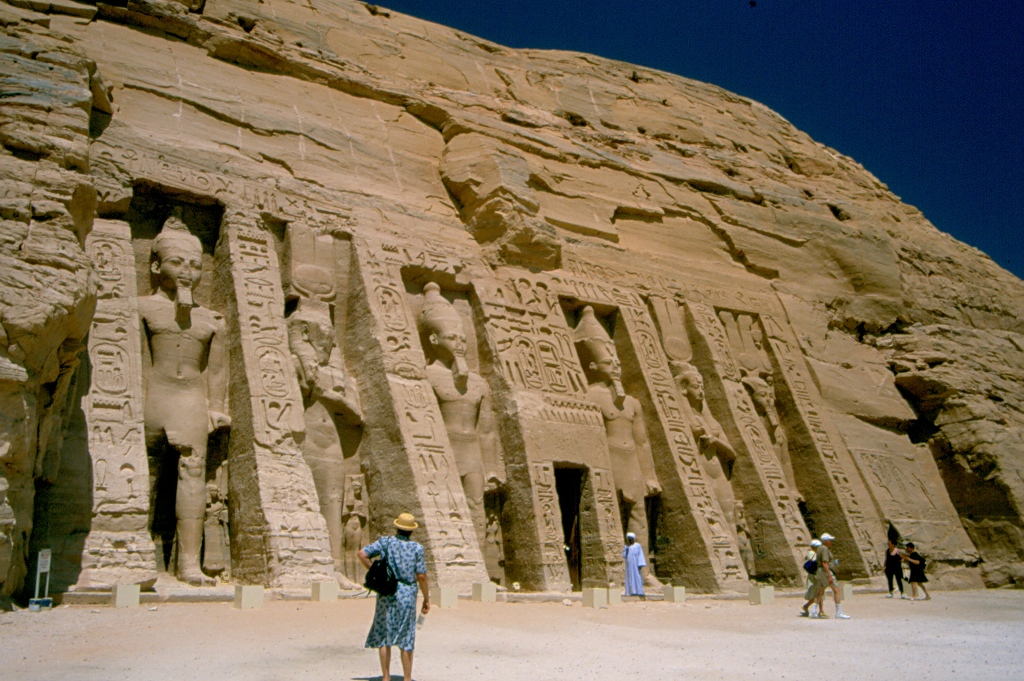 Abu Simbel, the Small Temple
Abu Simbel, the Small Temple
The statues are around 10 m tall and this is a rare case where the queen is shown in the same size as the pharaoh himself. It was common to show the queens and other members of the royal family in a smaller size, typically not higher than the knees of the pharaoh, like in the case of the Great Temple.
As for the ground plan of the Small Temple, it is similar to that of the Great Temple, but it is smaller, of course. The visitor first enters the hypostyle hall with six pillars on which, among other things, towards the top, it is possible to see the relief depictions of the head of goddess Hathor.
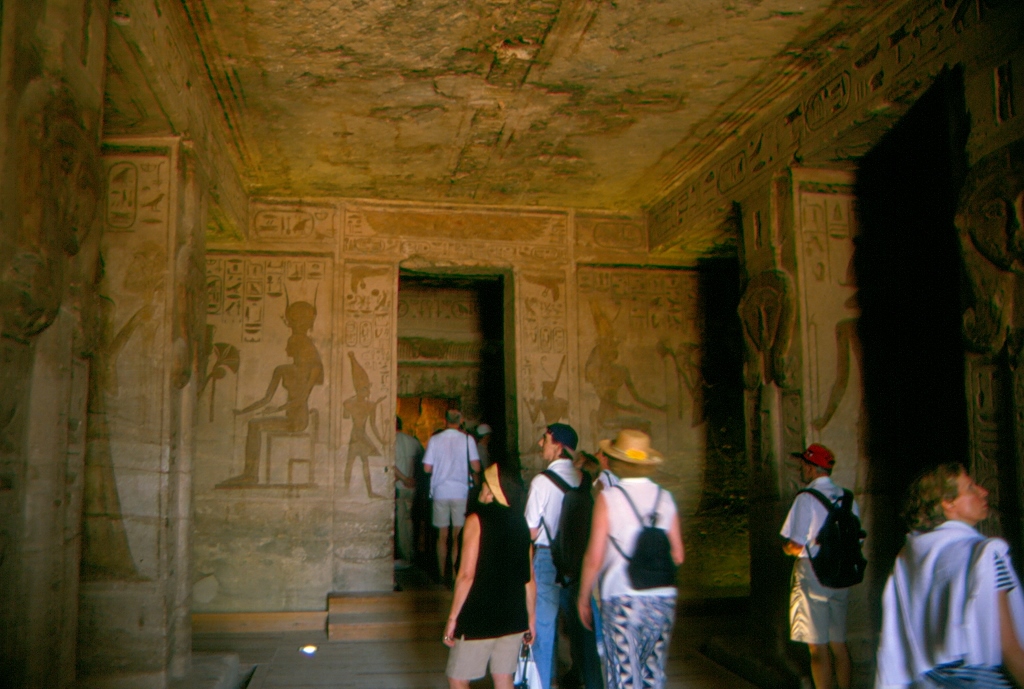 Abu Simbel, the Small Temple, the interior
Abu Simbel, the Small Temple, the interior
Here, too, the walls are decorated with reliefs and they mostly show the pharaoh and the queen in different situations that also include different deities. It is also shown how the pharaoh destroys his enemies before the gods in the presence of his wife.
There are three doorways that visitors can use to move from the hypostyle hall to a vestibule and in the back there is also a sanctuary, as well as a couple of side rooms. In the sanctuary itself, in a niche on the west wall, there is a depiction of goddess Hathor in the shape of a divine cow almost coming out from the mountain itself. All of this, as well as the interior of the Small Temple may be seen in the next video:
After the visit to the Small Temple, I just took a few more photos and then my mom and I could slowly head for the buses that took us back to the airport.
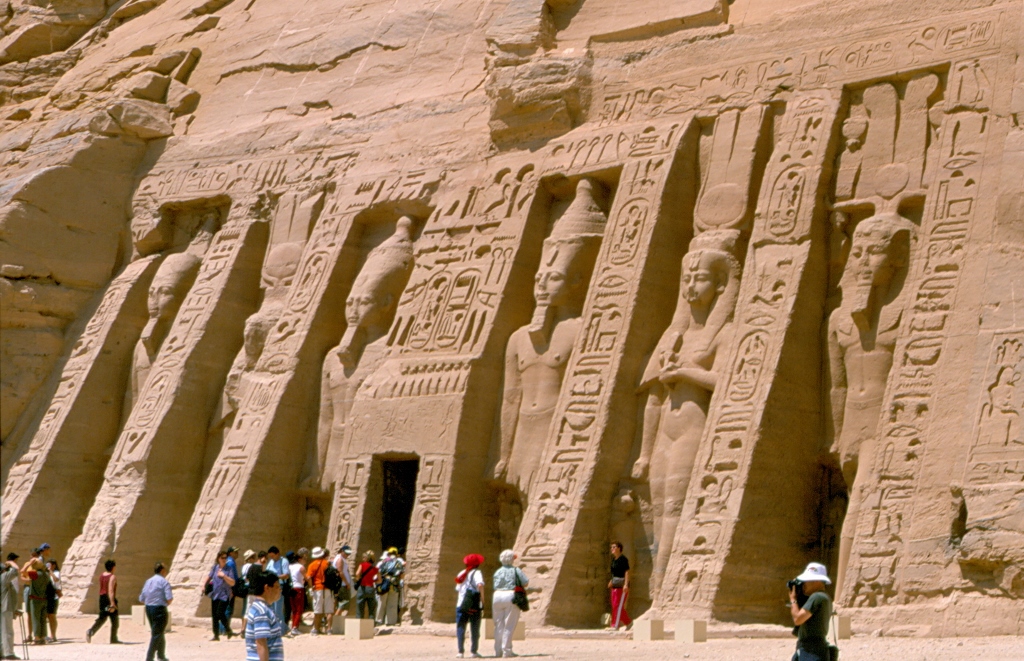 Abu Simbel, the Small Temple
Abu Simbel, the Small Temple
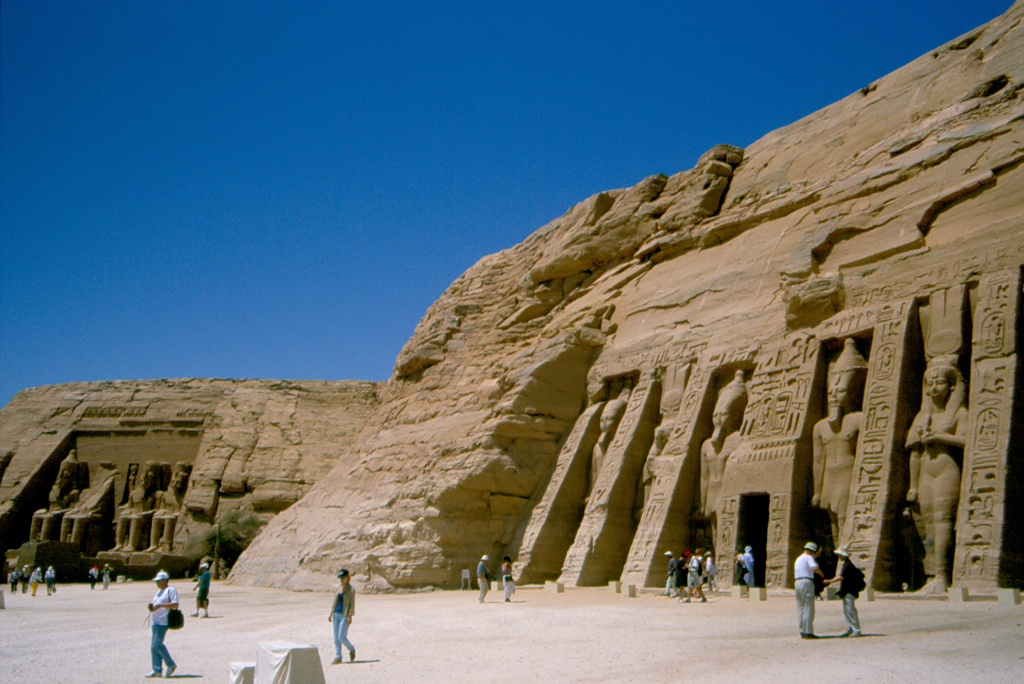 Abu Simbel, the Great Temple (left) and the Small Temple (right)
Abu Simbel, the Great Temple (left) and the Small Temple (right)
We waited a short while at the airport, but soon enough we were back in Aswan where we returned to the cruise ship with our room because soon after the Nile cruise started.
Although I am not at all attracted by those enormous cruise ships, I must admit that this easy going cruise along the Nile felt thoroughly enjoyable. These ships are like some fortresses. They are big and have several stories, but it is also very nice that on the top they have a small swimming pool (which in itself is just ok), as well as numerous sun loungers where travellers may lie comfortably in their swimsuits and possibly observe the slow passage by the riverbanks of the Nile. Since I was here in March, the sunrays were still not too strong, not even in south Egypt, so none of us got sunburnt. As for the cruise, to start with, the ships (and there are many of them and this cruise is a part of a popular tourist offer that may be found in Egypt) started to move away from the bank, manoeuvring carefully in order to get properly lined up and then the cruise could begin in earnest.
At the moment when we started to move I was in my room and so I watched through the window how we were moving away from the bank. At the same time, there was a group of workers on the shore placing new blocks of stone onto the slope of the bank, thus reinforcing it. Without any hurry in the world, one of them kept throwing a metal bucket into the Nile tied with a rope in order to catch some water which he would then pass to his colleague. And then, suddenly, he brought that bucket to his face and tilted it, quite clearly drinking the water!!! I was absolutely flabbergasted by the scene, as well as taken by surprise, so I did not have a photo camera ready. This was something quite unbelievable for me, for I kept hearing numerous stories about the water in the Nile, all sorts of amoebas and similar creatures that may cause serious health problems. Obviously this does not apply to everybody. The local population probably has some kind of immunity, but this is not so for us the newcomers.
Be as it may, once our ship got a good direction, we started slowly to cruise downstream to the north. I really enjoy rivers and that calm and slow ride was something that I found most pleasing and that I really took pleasure in. Admittedly, as the ship started with the cruise, there was more wind, but that certainly did not diminish in any way my enjoyment and the relaxing on the top deck.
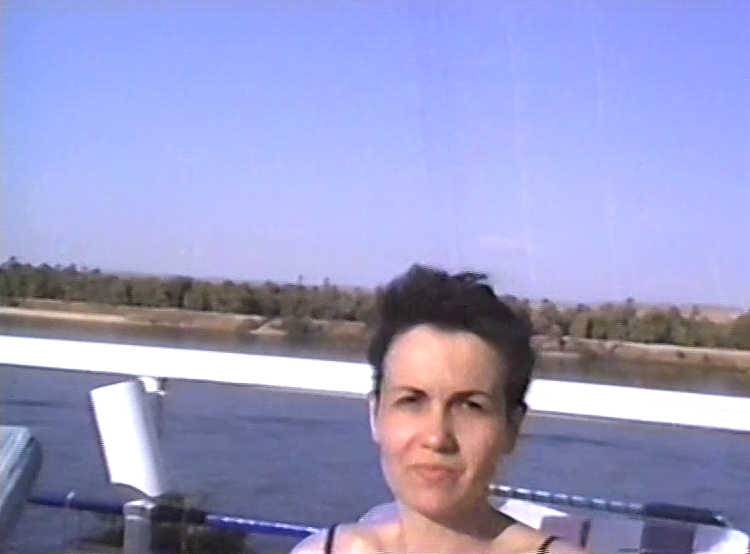 On a sun lounger on the top deck during the Nile cruise
On a sun lounger on the top deck during the Nile cruise
Of course, I could not lie down for long, it’s not in my nature, so I filmed and took photos from time to time.
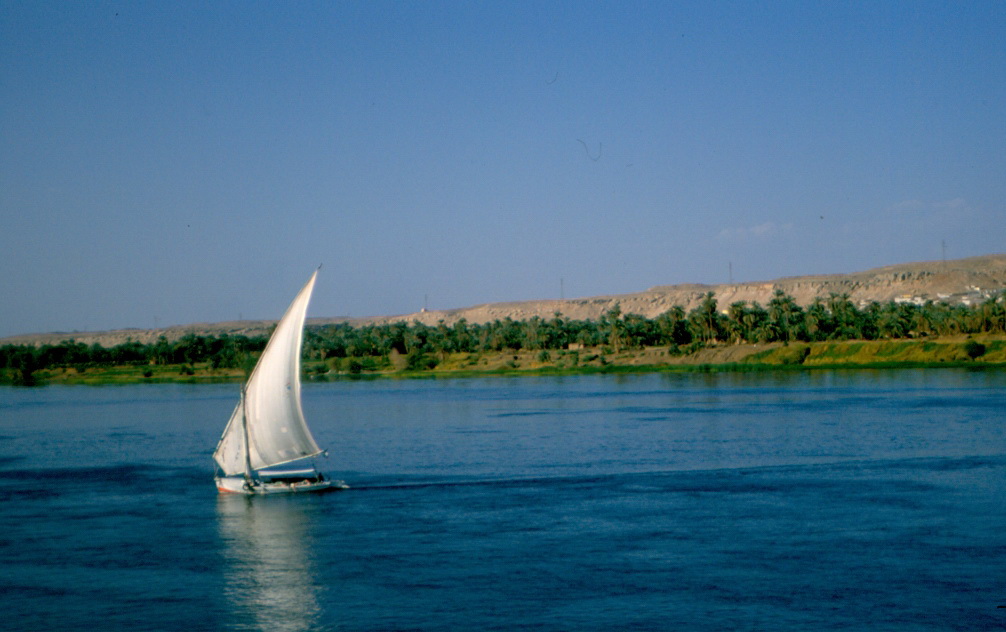 Scenes from the Nile
Scenes from the Nile
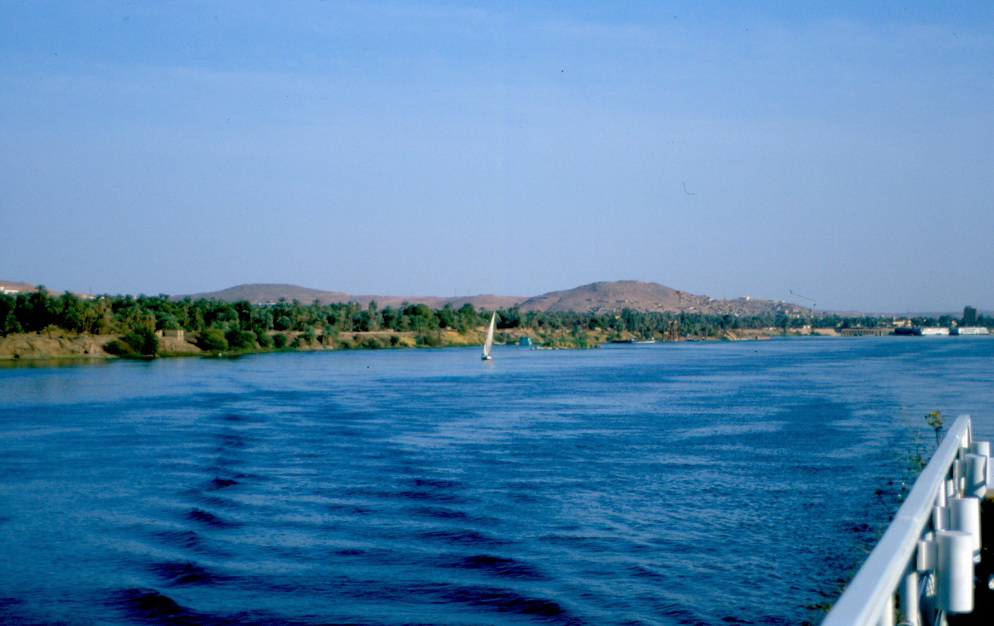 Scenes from the Nile
Scenes from the Nile
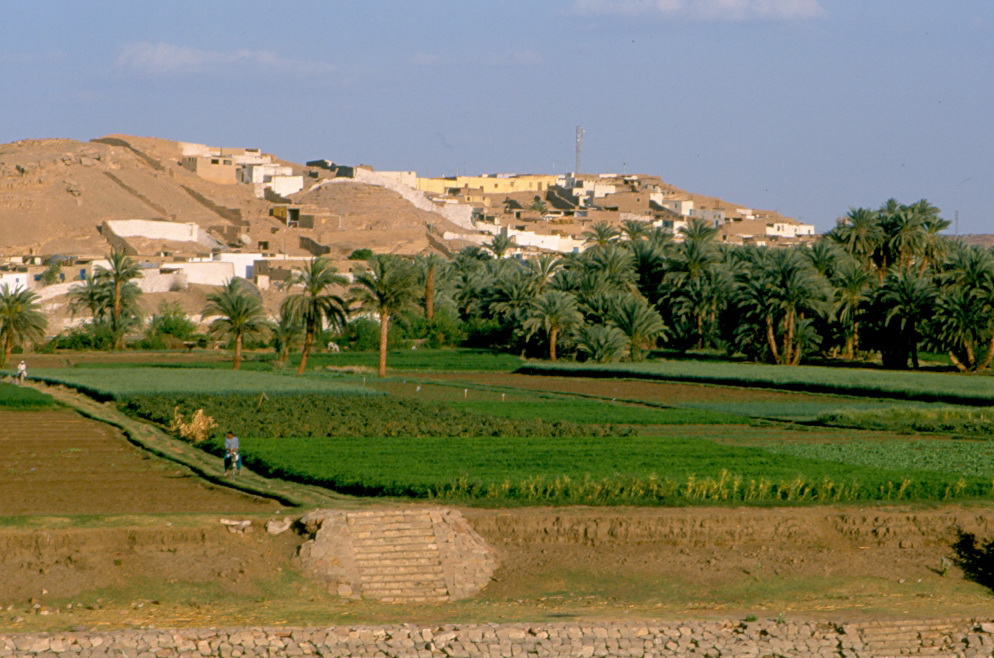 The Nile riverbank
The Nile riverbank
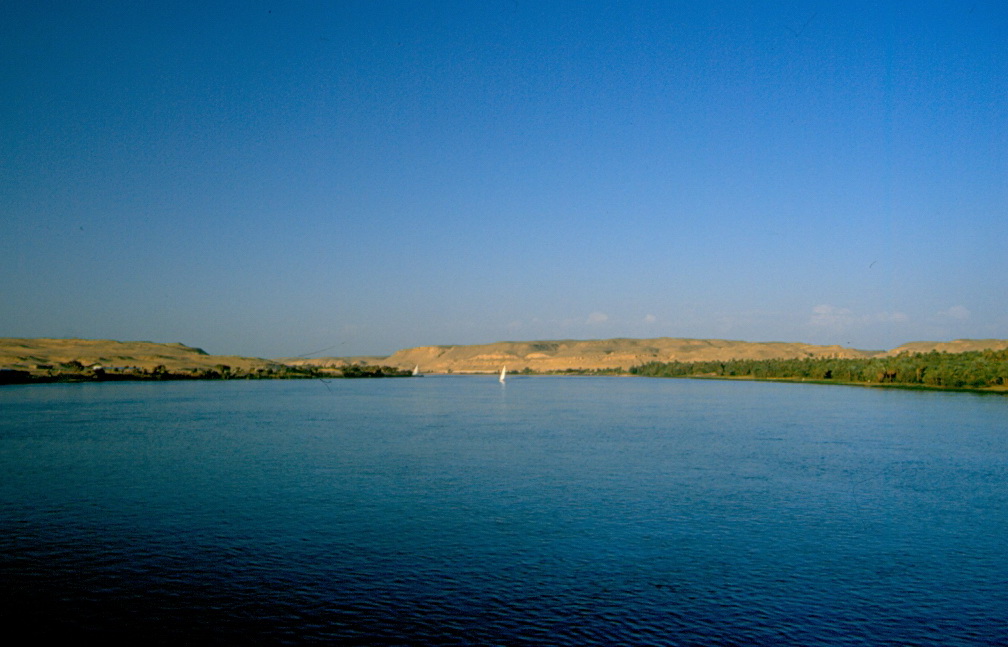 Scenes from the Nile
Scenes from the Nile
At some point, the Sun set and it started to get dark. Right about that time we reached the city of Kom Ombo which is one of the centres of agricultural production, but it is much better known among the visitors for its temple of the same name.